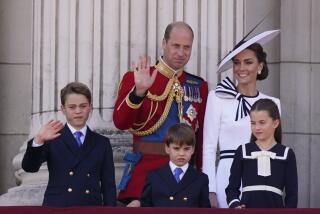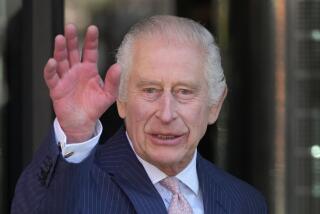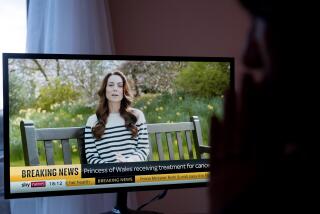Uppity Royals? Queenâs at McDonaldâs, Charlieâs Jolly
LONDON â First, the prince of Wales posed with the Spice Girls and Nelson Mandela during a trip to South Africa, looking so happy and relaxed that the Sunday Times called the once-dour king-in-waiting âCheerful Charlie.â
Then, on the eve of his 16th birthday, shy Prince William offered the world a peek into his private life with a few tidbits that portrayed him as an average teenager who enjoys techno music, action-adventure books and his black Labrador, Widgeon.
To top it off, last month Queen Elizabeth II stepped out of her palace and stopped by a McDonaldâs. She neither drove the Rolls-Royce nor tasted a Big Mac, but there was her majesty in a canary yellow suit and matching hat, white gloves and handbag, mixing it up with the folks outside a burger joint.
The crowd ate it up. So did the press.
In the year since Britainâs beloved Princess Diana died in a Paris car crash and the house of Windsor came under attack for being so remote, the royals have been working overtime to improve their image and accessibility. While no one would call them the âpeopleâs monarchy,â their labors are paying off.
For the first time in four years, a majority of Britons thinks Charles would make a good king, according to a Guardian newspaper poll published this month. Similarly, 58% of those polled by the Sunday Times said they thought he is âfit to be king,â and 63% said the country would be worse off if the monarchy were abolished.
This is a remarkable turnaround for the royal family, for whom Dianaâs death last Aug. 31 initially seemed to be as problematic as her rebellious life.
The members of the monarchy, which had lost stature during the acrimonious divorce of Charles and Diana, seemed coldly out of touch after she died when they withdrew behind the walls of their Scottish castle, Balmoral, to mourn in private while the rest of the country poured into the streets to grieve publicly.
The family did emerge a few days later to thank the millions of people who had left their flowers and tears on Dianaâs doorstep at Kensington Palace, and the queen went on national television to pay tribute to the princess.
But at Dianaâs funeral service in Westminster Abbey, Charles Spencer, her younger brother and the ninth Earl Spencer, implicitly rebuked the royal family for having stripped his sister of the title âher royal highnessâ after her 1996 divorce from Charles. His thinly veiled criticism of the familyâs stiff adherence to protocol--through his vow to protect Dianaâs two sons from a world of âduty and traditionâ--drew applause from the throngs gathered outside.
*
The events left Britons craving a gentler monarchy to fill the void left by the âpeopleâs princess,â as Prime Minister Tony Blair called her. It spurred demands that the cost and role of the monarchy be diminished, and even fueled a small republican movement to do away with it altogether.
Even before Dianaâs death, the royal family had taken modest steps toward modernization. The queen began paying taxes, and Buckingham Palace got a Web site. Prince Charles established a committee to chart the house of Windsorâs path into the 21st century.
Under the tutelage of Blair, a master of public relations, the family has taken further measures to appear modern, conceding that princesses should have the same rights of succession to the throne as princes and making curtsying before the queen optional. Plans to renovate the royal yacht were scrapped. Buckingham Palace also has hired a new royal spin doctor, a 39-year-old public relations whiz credited with improving the fat-cat image of British Gas executives.
But much of his work is already done. The biggest improvement in the image of the royal family may be due more to the fact that it no longer has to compete--and contend--with Diana than to any PR campaign.
*
Dianaâs beautiful face still sells more magazines than any of the royals, and the tabloids look for any excuse to put her picture on the front page. She still holds a special place in the hearts of most Britons as a woman who was at once a victim and a healer.
But Diana is no longer around to upstage her ex-husband, who always seemed dull beside her glamour. She is no longer a loose cannon firing at the royal family through the media, which she managed so much better than they did.
âThere are no changes of substance whatsoever in the monarchy,â said David Starkey, a constitutional historian at Fitzwilliam College, Cambridge University. âThere is no trace of âDianafication,â because Diana was Diana. You really canât imagine the queen having a good boo-hoo with an AIDS victim.
âWhat has happened, really, is that Diana is dead and the problem for the monarchy was Diana alive,â Starkey said. âThey were constantly being judged against her.â
Most of all Charles, who so often looked sullen and miserable throughout the coupleâs public quarrel. The fuddy-duddy next to the star.
Now Charles looks as if he has been released from a straitjacket. He smiles more often and more naturally and seems a gentler figure as a single father looking out for the young princes who lost their mother. He appears confident, âthe sort of man people might want for their king,â the Sunday Times reported after his trip to South Africa with 13-year-old Prince Harry.
He is more at ease.
âDribbling home-brew Zulu beer down his chin and beaming at the sight of 21 pert-breasted tribal dancers, Charles seemed to have grown back into his own skin--or found a new one,â the newspaper reported.
He didnât have to worry about anyone comparing his performance with how Diana might have behaved on such a mission. And if he still came across as aloof at times, he was portrayed as less arrogant than he used to be, rather than as more remote than Diana.
In recent months, Charlesâ relationship with Camilla Parker-Bowles, whom Diana had accused of crowding her marriage, also has been brought more into the open.
The British press, which agreed to keep its distance from Dianaâs sons after her death, reported a chance meeting between Prince William and Parker-Bowles in June. William had traveled to London from his boarding school to go to the movies with friends and made an unscheduled stop to change clothes at his fatherâs place, St. Jamesâ Palace. Parker-Bowles was there.
*
According to the British press, Charles gave his son the choice of greeting her or not and William opted to say hello. The two engaged in light conversation for half an hour over soft drinks.
The fact that this story leaked out and was confirmed by official spokesmen led to speculation that it was part of an effort to gain public acceptance of Parker-Bowles, who subsequently attended an early 50th birthday party that the young princes threw for Charles.
This too seems to be having its effect. The press has been publishing more flattering pictures of the royal mistress. Asked recently by the Guardian if Charles should marry Parker-Bowles, 35% of respondents said yes, compared with 30% in October; 46% were against marriage, compared with 55% in the earlier poll.
While Charles has seen his popularity rise sharply in the last year, it still lags behind the queenâs. Of those polled by the Sunday Times, 62% said she should never abdicate. In another poll, published Thursday, 73% said they are satisfied with the job the queen is doing.
It is unclear whether that satisfaction has come despite or because of the queenâs efforts to be more accessible. She has let it be known that she communicates with the young princes by e-mail, rather than quill pen, has invited rock stars to Buckingham Palace and made her now-famous stroll among the McDonaldâs crowd.
âI mean, what a place to choose,â sniffed Starkey, the historian. âIâve never been to McDonaldâs. Itâs just a question of taste.â
More to Read
Sign up for Essential California
The most important California stories and recommendations in your inbox every morning.
You may occasionally receive promotional content from the Los Angeles Times.










